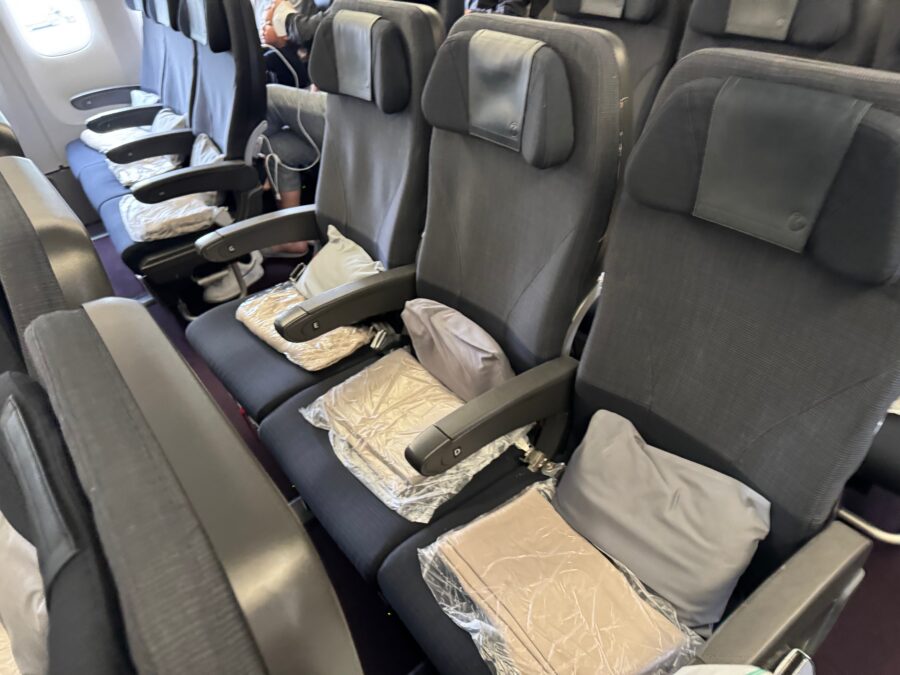I am getting to be an old man and although I am reaching the point where a premium economy or business class seat for a six-hour-flight becomes a necessity for my aching butt, there are occasions where I will make an exception. Naturally, an airline with one of the biggest legrooms in the industry is one for which I will happily make an exception. This is the case with Japan Airlines and its industry-leading 34 inches of legroom. On a recent flight from Tokyo Haneda to Bangkok Suvarnabhumi, the economy class experience on Japan Airlines was an eminently enjoyable ride to Bangkok.

The economy seat on Japan Airlines’ Boeing 777-300ER
Though we boarded just 20 minutes before departure, we left on time and unsurprisingly for a Japanese airline, getting everyone on the plane and settled was quick and efficient. There were a crazy amount of people in Zone 1 and 2, apparently reflecting that the airline has a lot of dedicated loyalty members.


On top of the aforementioned great stretch space of the economy seats, the width of these JAL seats is a bit more substantial than most economy class seats. Coming in at 19 inches across as opposed to a more standard 18.5 inches, this allows JAL to seat economy at 3-3-3 across as opposed to 3-4-3 like most US and European airlines do.Every seat has a USB charger on the seat back as well as AC power under the seat. There’s a cute little bottle holder and in the seatback pocket there is a good old fashioned airplane magazine, which I really appreciated. The recline is comfortable for the user and not a disturbance to the passenger behind.

While there is a strong selection of movies available on the in-flight entertainment system (I finished up the second half Killers of the Flower Moon), I found the navigation of the IFE system a bit antiquated and the roar of the engines quickly overcame the dialogue of the movie even at full blast volume given the shoddy little headphones which are handed out. I really can’t wait for more airlines to move to a Bluetooth connective approach for their IFE systems.
The food and beverage on Japan Airlines’ Boeing 777-300ER
Lunch was served not long after takeoff, but not before a drink service with a package of rice crackers and a hot towel. I went for a cold green tea, but you could also order orange, apple or tomato juice, Coke, Sprite, water, hot tea or coffee, or the JAL signature beverage, the original Skytime peach and grape mix. In terms of alcoholic offerings, they had wine, beer, Japanese sake, whisky gin, plum wine, vodka or brandy. In the premium economy class they also serve champagne and Japanese shochu. While sometimes you see bubbles in premium economy cabins, it’s usually cava or prosecco and you rarely see real champagne outside of business class or first class.

There were two options offered for lunch – butter chicken (presumably a Japanese version, not the Indian one) and ginger pork. I chose the latter, which was served with a salad and a couple of Japanese appetizers. Miso soup was poured from a coffee thermos into a paper cup and I enjoyed another glass of green tea. Lunch was also served with a full bottle of water which I appreciated. It’s always impressive when an economy lunch is tastier than something you might eat in a premium cabin on another airline and this was the case with my lunch on JAL. Afterwards, they came around with ice cream, and though it wasn’t the flavor I would have chosen given the chance (caramel) it was still Häagen-Dazs, which was pretty swanky!



The service on Japan Airlines’ Boeing 777-300ER
Like everyone in Japan, the flight attendants on JAL take their job extremely seriously and want move about the cabin as busy as bees for the entirety of the flight. I was shocked to see, not long before we began our initial descent, a flight attendant with a small handheld vacuum cleaner, cleaning up the crumbs on the aisle carpeting. I’d only seen anything like this once before, when a flight attendant on All Nippon Airways (ANA), Japan’s other flag carrier doing the same mid-flight, but crumb by crumb with a piece of tape!
The bathrooms were spotless and were equipped with far more toiletries than you would usually (soap, lotion, air freshener, etc.) expect in economy as well as a built-in bidet, which I just love.

While you can get accustomed to less than stellar English in Japan, all of the flight crew spoke good English and were friendly and professional when taking and delivering orders. As with many Japanese flights, we were sent off with a bow by the wing walkers, and though I didn’t check baggage, I’m sure that the suitcases were delivered quickly and gently as well. We arrived a few minutes before schedule and immigration at Suvarnabhumi was a breeze.
The bottom line
There are few things better than a daytime flight with no turbulence and a fairly comfortable seat. As JAL’s economy class exemplifies, it doesn’t actually need to be a fancy seat at all! I could easily fly their economy product for double the length of the flight from Tokyo to Bangkok. While JAL’s approach is very premium cabin heavy (if you ever look at a seat map of one of their planes, it’s a bit shocking how few of the seats are economy) they don’t cut any corners on their seats in the back of the bus. While I can’t wait to sample their business or first class product on the new A350-1000, their economy offering is a perfectly suitable way to cross an ocean as well.

